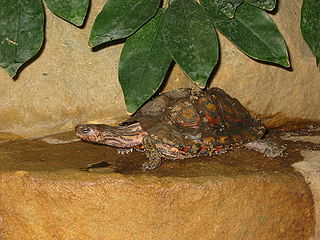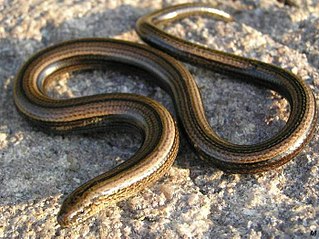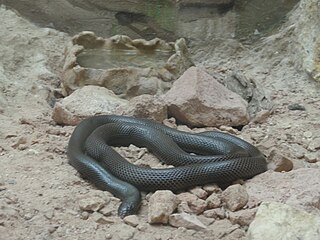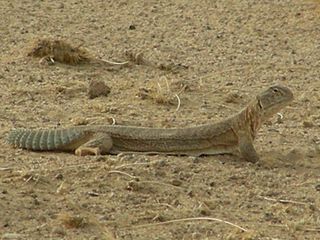
The Viperinae, or viperines, are a subfamily of vipers endemic to Europe, Asia and Africa. They are distinguished by their lack of the heat-sensing pit organs that characterize their sister group, the subfamily Crotalinae. Currently, 13 genera are recognized. Most are tropical and subtropical, although one species, Vipera berus, even occurs within the Arctic Circle. Like all vipers, they are venomous.

Colubridae is a family of snakes. With 249 genera, it is the largest snake family. The earliest species of the family date back to the Oligocene epoch. Colubrid snakes are found on every continent except Antarctica.

The Geoemydidae are one of the largest and most diverse families in the order Testudines (turtles), with about 70 species. The family includes the Eurasian pond and river turtles and Neotropical wood turtles. Members of this family are commonly called Leaf turtle.

Pelomedusidae is a family of freshwater turtles endemic to sub-Saharan Africa, including Madagascar, São Tomé, and the Seychelles(Although this pop. may have been introduced by humans). They range in size from 12 to 45 cm in carapace length, and are generally roundish in shape. They are unable to fully withdraw their heads into their shells, instead drawing them to the side and folding them beneath the upper edge of their shells, hence are called African side-necked turtles.

The Tropiduridae are a family of iguanid lizards. The family is sometimes considered a subfamily, Tropidurinae. The subfamily is native to South America, including the islands of Trinidad and the Galápagos. Commonly known as neotropical ground lizards, most are ground-dwelling animals, and the subfamily includes some lizards adapted to relatively cold climates, including those of the Andes mountains and Tierra del Fuego. Several species give birth to live young.

Pygopodidae, commonly known as legless lizards, snake-lizards, or flap-footed lizards, is a family of squamates with reduced or absent limbs, and are a type of gecko. At least 35 species are placed in two subfamilies and eight genera. They have unusually long, slender bodies, giving them a strong resemblance to snakes. Like snakes and most geckos, they have no eyelids, but unlike snakes, they have external ear holes and flat, unforked tongues. They are native to Australia and New Guinea.

Anguidae refers to a large and diverse family of lizards native to the Northern Hemisphere. Common characteristics of this group include a reduced supratemporal arch, striations on the medial faces of tooth crowns, osteoderms, and a lateral fold in the skin of most taxa. The group is divided into two living subfamilies, the legless Anguinae, which contains slow worms and glass lizards, among others, found across the Northern Hemisphere, and Gerrhonotinae, which contains the alligator lizards, native to the Americas. The family Diploglossidae was also formerly included. The family contains about 87 species in 8 genera.

Skinks are lizards belonging to the family Scincidae, a family in the infraorder Scincomorpha. With more than 1,500 described species across 100 different taxonomic genera, the family Scincidae is one of the most diverse families of lizards. Skinks are characterized by their smaller legs in comparison to typical lizards and are found in different habitats except arctic and subarctic regions.

Emoia is a genus of skinks, lizards in the subfamily Eugongylinae. The genus Emoia belongs to a group of genera mainly from the southwestern Pacific-Australian region.

The Atractaspididae (atractaspidids) are a family of venomous snakes found in Africa and the Middle East, commonly called mole vipers, stiletto snakes, or burrowing asps. Currently, 12 genera are recognized.

Myobatrachidae, commonly known as Australian ground frogs or Australian water frogs, is a family of frogs found in Australia and New Guinea. Members of this family vary greatly in size, from species less than 1.5 cm (0.59 in) long, to the second-largest frog in Australia, the giant barred frog, at 12 cm (4.7 in) in length. The entire family is either terrestrial or aquatic frogs, with no arboreal species.

Hydrophis is a genus of sea snakes, venomous snakes in the subfamily Hydrophiinae of the family Elapidae. Species in the genus Hydrophis are typically found in Indo-Australian and Southeast Asian waters. Currently, around 36 species are recognized as being valid.

Euhelopodidae is a family of sauropod dinosaurs of disputed membership and affinities, which contains Euhelopus and its close relatives. Most proposed euhelopodids are from East Asia.

The Alethinophidia are an infraorder of snakes that includes all snakes other than blind snakes and thread snakes. Snakes have long been grouped into families within Alethinophidia based on their morphology, especially that of their teeth. More modern phylogenetic hypotheses using genetic data support the recognition of 19 extant families, although the taxonomy of alethinophidian snakes has long been debated, and ultimately the decision whether to assign a particular clade to a particular Linnaean rank is arbitrary.

Diploglossidae is a family of anguimorph lizards native to the Americas, with most genera being endemic to Hispaniola. Most members of this family are known as galliwasps. They were formerly considered a subfamily of Anguidae, but genetic evidence has shown them to be less closely related to other members of Anguidae than Anniellidae is.

The Herpesvirales is an order of dsDNA viruses with animal hosts, characterised by a common morphology consisting of an icosahedral capsid enclosed in a glycoprotein-containing lipid envelope. Common infections in humans caused by members of this order include cold sores, genital herpes, chickenpox, shingles, and glandular fever. Herpesvirales is the sole order in the class Herviviricetes, which is the sole class in the phylum Peploviricota.

Saara is a genus of lizards in the subfamily Uromasticinae of the family Agamidae. The genus is endemic to Asia.

The Lamprophiidae are a family of snakes found throughout much of Africa, including the Seychelles. There are 89 species as of July 2022.

Colubroidea is a superfamily of snakes in the clade Colubroides that includes Colubridae, with some studies splitting Colubridae into multiple families that make up Colubroidea. Historically, Colubroidea also included other caenophidian snakes such as cobras and vipers, as these snakes form a clade. However these groups are now divided into several distinct, but related, families. Zaher et al. (2009) proposed to redefine Colubroidea for colubrids and related families, while designating Colubroides as the group containing vipers and cobras as well as colubroids. The ReptileDatabase considers Colubroidea to be composed of Colubridae and the members of its sister group, Elapoidea, and does not recognize the division of Colubridae into multiple families.

Acrodonta are a subclade of iguanian squamates consisting almost entirely of Old World taxa. Extant representation include the families Chamaeleonidae (chameleons) and Agamidae, with at least over 500 species described. A fossil genus, Gueragama, was found in Brazil, making it the only known American representative of the group.






















